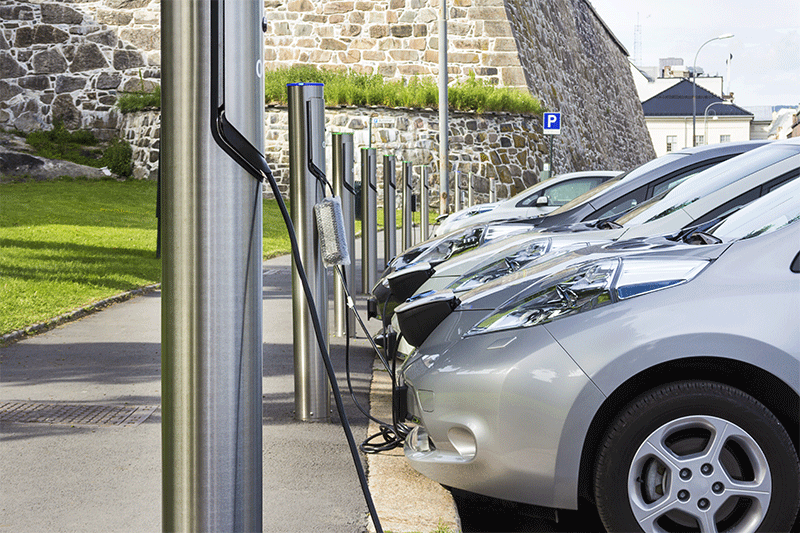Dreaming of electric mobility
To develop electric mobility we must put into place an efficient charging infrastructure and control the flow of energy: the solutions exist.
Written by:
Laurent De Vroey
ENGIE Laborelec
ENGIE Research
Read the PDF article here
Special issue in partnership with ENGIE
April 2020

2020 Monday morning. I wake up after a night that was far too short and listen to the traffic report. It couldn’t be worse: I’m going to be stuck in traffic jams all the way to work and what’s more I need to get petrol! Crawling along the clogged roads, I am surrounded by anonymous vehicles, each with a single occupant. The clock is ticking and the engines are running, but the cars aren’t moving. Once in town, the next challenge is finding somewhere to park, and to top it all off, there’s the short walk to the office in the midst of noise and exhaust fumes. I can’t wait to be at work!
2035 Monday morning. The night was still too short, but I got an extra hour’s sleep this time. My favourite app shows me today’s best mobility option: a shared electric car to the station, the train and then a self-service electric scooter. The hustle and bustle of the city hasn’t changed, but it’s so much quieter and the air is cleaner now towns and cities have banished the internal combustion engine!
Multi-modal transport solutions and electric mobility have really changed the game. Why did we wait so long?
Mobility and transport are the cornerstones of modern society, whether for practical reasons or for the freedom they offer. The need to significantly reduce the transport sector’s carbon emissions is inciting a growing number of public and private stakeholders to encourage the development of electric mobility, however for the sector to grow, many practical problems facing both users and society will need to be resolved. Two such issues are where to recharge electric vehicles (charging infrastructure) and the energy demand in play.
AN OPTIMIZED INFRASTRUCTURE
There are several options available to the people in charge of deploying an EV charging infrastructure capable of meeting requirements. The first parameter to take into account is the speed of charging. Charging for one hour at a simple wall socket increases the car’s range by 10 to 15 kilometers. The same amount of time at a standard charging station will increase its range by up to 100 kilometers. A fast-charging station (larger and more complex) will do the same in just 15 minutes! However, charging speed raises questions of power, which we will come back to later. Another parameter is the technology used for charging that can be either conductive or inductive (depending on whether the vehicle is plugged in or charged wirelessly). The former is more efficient, but the latter is more practical. Different charging structures are available depending on the usages including plug-in charging stations and pantograph charging (using an articulated arm that can be deployed above electric buses for example). Depending on the chosen solution, charging can take place when the vehicle is stationary or even in motion.
MATURITY AND AGING
There are a whole multitude of possibilities and so, to get a clearer idea, ENGIE is studying these different charging solutions, taking a particular interest in the maturity of their technology, their impact on vehicle aging, their interoperability, and their potential to be rolled out in the medium and long term. To this end, researchers are regularly carrying out in-depth evaluations of charging solutions and technologies, both in the laboratory, during field tests and as part of an in-depth analysis of solutions already deployed around the world.
Other tests included the impact of rapid charging on battery aging compared to normal charging and the possibility of the electric car returning energy to a building or to the grid. The ease of installation and use of different charging solutions has also been tested in real-life conditions.
The other aspect of the deployment of electric mobility concerns the amount of electricity required to supply the vehicles and its availability. This question is directly related to the number and size of the batteries in use. In Europe, an all-electric mobility and transport solution would lead to an increase in electrical energy requirements of between 15 and 20%. While this increase is significant, it would be manageable if it were spread out over time.
FASTER, CHEAPER AND WORRY FREE
By avoiding large investments, reducing power demand and the number of chargers required, smart charging provides users, charging stations and grid operators with a whole host of advantages. Smart charging consists in adapting vehicle charging to other consumption needs on-site and maximizing the use of locally produced energy (produced for example by solar panels). A growing number of commercial solutions offer some of these functions, however all of them can be found in SMATCH, ENGIE’s solution for electric vehicle charging. What’s more, SMATCH takes into account the specific needs of each individual user, as well as anticipating local production, consumption and vehicle requirements. It also considers network constraints, energy market tariffs and CO2 production depending on the energy mix, which varies over time.
A NEED FOR POWER
Another essential factor to take into account is that, as we have seen, the speed of charging can cause power problems. Charging a single electric vehicle in the time it takes to fill up a traditional car with petrol would require power equal to that delivered by a wind turbine running at full speed. This is impossible in practice. In addition, and depending on the location, the capacity of the electricity network is not always sufficient to meet the demand that would be generated by the simultaneous charging of a large number of electric vehicles. In this case, smart charging will be essential.
Moreover, the way in which vehicles are charged can lead to anomalies on the electricity network (voltage drops, overloading of transformers and frequency variation, etc). After a certain point, these disruptions would require action and would lead to considerable costs. To tackle these problems, ENGIE is working with various electricity network operators to assess the qualitative and quantitative impacts of these disruptions by carrying out detailed measurements of charging cycles for different types of chargers and electric vehicles.
Finding answers to these questions is all the more important as electric mobility is widely accepted today and set to grow. Studies show that 95% of electric car users would not want to go back to an internal combustion engine.
All sorts of new opportunities are opening up. Depending on the needs, we can imagine situations in which electric vehicles could supply energy to buildings or to the grid. These new perspectives for battery use would help to maximise local consumption of intermittent renewable energy production. The same concept can be extended to local energy communities: one household’s electricity production could help to charge a neighbour’s vehicle and another person’s vehicle could supply power to the home of a fourth person. The development of such communities would impose a real paradigm shift of which electric mobility is only a first step. By getting involved in such projects, you can make the dream of 2035 come true… and get a better night’s sleep!